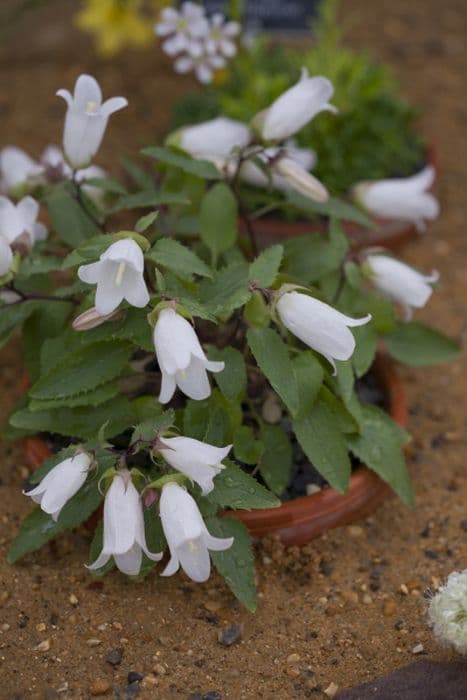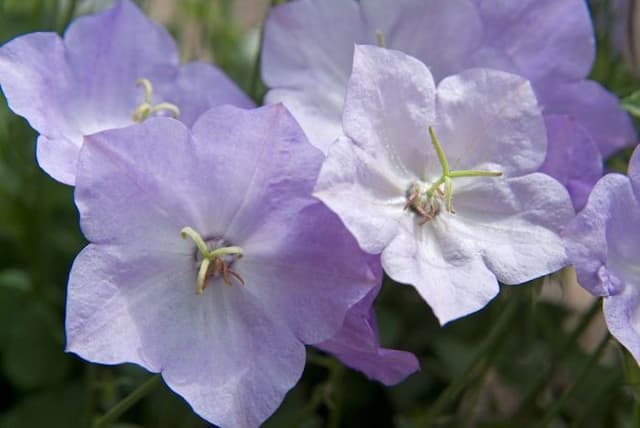Milky Bellflower Campanula lactiflora Avalanche = 'Camblo'
![milky bellflower [Avalanche]](/_next/image?url=https%3A%2F%2Fplants-admin.emdemapps.com%2Fimages%2Fplants%2F%2Fimages%2F604b5dc88c1e7.png&w=3840&q=75)
ABOUT
The Campanula lactiflora Avalanche, commonly known as the Milky Bellflower, is a perennial plant that is distinguished by its graceful and sturdy stems, which bear clusters of bell-shaped flowers. The blossoms are a delicate shade of white, lending an air of elegance and purity to the overall appearance of the plant. Each flower is composed of a series of overlapping petals that form a cup-like shape, inviting various pollinators to visit. The foliage of the Milky Bellflower is equally attractive, with leaves that have a somewhat lance-shaped appearance. The green of the leaves is a deep, rich tone, providing a lush background for the pristine white flowers. The leaves are arranged alternately along the stems, contributing to an overall appearance of fullness and vitality. As the flowers bloom in clusters at the top of each stem, they create a bountiful and cascading effect that is reminiscent of a floral avalanche, hence the cultivar name 'Avalanche'. The flowers and foliage together compose an image of robust health and natural beauty, making the Milky Bellflower an appealing choice for gardeners looking to add a touch of charm to their garden borders or floral arrangements.
About this plant
 Names
NamesFamily
Campanulaceae.
Synonyms
Milky Bellflower, Broad-leaved Bellflower, Giant Bellflower.
Common names
Campanula lactiflora Avalanche.
 Toxicity
ToxicityTo humans
The Milky Bellflower is generally not considered toxic to humans. There are no significant symptoms associated with ingesting this plant. However, as with any plant, individual allergies or sensitivities could potentially cause mild discomfort or reactions in some people.
To pets
The Milky Bellflower is also not known to be toxic to pets. It is not typically associated with any symptoms of poisoning in animals such as dogs or cats. Again, individual sensitivities could potentially cause mild gastrointestinal upset if ingested, but it is not commonly reported as a harmful plant to pets.
 Characteristics
CharacteristicsLife cycle
Perennials
Foliage type
Deciduous
Color of leaves
Green
Flower color
Blue
Height
3-4 feet (0.91-1.22 meters)
Spread
2-3 feet (0.61-0.91 meters)
Plant type
Herb
Hardiness zones
3-8
Native area
Caucasus
Benefits
 General Benefits
General Benefits- Attracts Pollinators: Campanula lactiflora Avalanche, commonly known as the Milky Bellflower, is highly attractive to bees and butterflies, which play a crucial role in pollination.
- Garden Aesthetics: With its tall spikes of lavender-blue flowers, it adds vertical interest and a splash of color to garden beds and borders.
- Cut Flowers: The blooms make excellent cut flowers for vases and floral arrangements, offering a long vase life and charming cottage garden aesthetic.
- Low Maintenance: Once established, the Milky Bellflower is relatively low maintenance, requiring minimal care to thrive and bloom.
- Drought Tolerant: This plant is fairly drought-tolerant, making it a good choice for gardens in drier climates or for gardeners looking for water-wise plants.
- Cold Hardy: It is cold hardy and can withstand cooler temperatures, which makes it suitable for a wide range of climates.
- Versatility: The plant can be used in mixed borders, cottage gardens, and woodland garden settings, demonstrating great versatility in landscape design.
 Medical Properties
Medical PropertiesThis plant is not used for medical purposes.
 Air-purifying Qualities
Air-purifying QualitiesThis plant is not specifically known for air purifying qualities.
 Other Uses
Other Uses- As a natural dye: The blossoms of the Milky Bellflower can be used to create a gentle blue dye for fabrics or artworks.
- In photography: The striking flowers can be used as a subject for macro photography to capture intricate details and patterns.
- In floral waters: Petals can be steeped in water to create a subtly scented floral water for room or linen sprays.
- As an educational tool: Teachers can use the plant in botany lessons to explain plant anatomy and pollination.
- For ink making: The petals can potentially be used to make natural inks for calligraphy or painting when mixed with appropriate mordants or binders.
- As a sleep aid: Dried flowers may be included in homemade sleep pillows or sachets to promote relaxation with their gentle scent.
- In crafts: The flowers and stems can be pressed and used in creating bookmarks, greeting cards, and other paper crafts for unique botanical designs.
- For candle making: Incorporated into homemade candles for decorative elements, Milky Bellflower petals can add botanical interest to the craft.
- In fabric softener: Dried petals might be infused in vinegar-based homemade fabric softeners to add a light fragrance to laundry.
- As a natural confetti: Dried petals can be used as an eco-friendly alternative to traditional paper confetti at celebrations such as weddings or garden parties.
Interesting Facts
 Feng Shui
Feng ShuiThe Milky Bellflower is not used in Feng Shui practice.
 Zodiac Sign Compitability
Zodiac Sign CompitabilityThe Milky Bellflower is not used in astrology practice.
 Plant Symbolism
Plant Symbolism- Perseverance: The 'Camblo' is known to be a hardy plant that can grow in a variety of conditions, symbolizing the ability to persevere through challenging times.
- Gratitude: In the language of flowers, campanulas are often associated with gratitude and the sentiment of 'thank you,' making the 'Camblo' a perfect gift to show appreciation.
- Constancy and enduring love: These plants often symbolize unwavering affection and the continuity of feelings, which is reflected in the bell-like shape of their flowers that seem steadfast and reliable.
- Humility: The bell shape of the 'Camblo' blooms face down, which traditionally is seen to represent humility in the language of flowers.
 Water
WaterThe Milky Bellflower requires consistent moisture, so water when the top inch of soil feels dry to the touch. On average, this may translate to watering once a week, but adjust as needed for weather conditions and soil drainage. Provide enough water to moisten the soil to a depth of about 6 inches. During hot, dry spells, the plant may need watering twice a week. Always avoid overhead watering to prevent foliar diseases; instead, water directly at the base of the plant. Depending on the size of the plant and environmental conditions, a general guide would be to use approximately 1-2 gallons of water per week for an established plant.
 Light
LightThe Milky Bellflower thrives best in full sun to partial shade. An ideal spot would be one that receives morning sun and afternoon shade, especially in hotter climates. The plant needs a brightly lit position but appreciates protection from the harsh midday sun, which can scorch the leaves and blooms.
 Temperature
TemperatureThe Milky Bellflower prefers a temperate climate and fares well in temperatures ranging from 60°F to 75°F. It is hardy in USDA zones 4 through 8 and can survive winter lows down to about -20°F. It should be protected from extreme heat, as temperatures consistently above 85°F may stress the plant.
 Pruning
PruningThe Milky Bellflower should be pruned to remove spent blooms and encourage a second flush of flowers. Deadheading regularly throughout the flowering season can improve the plant's appearance and vigor. Cut back the stems to the base in late fall after flowering is complete to maintain a tidy plant and prepare for winter.
 Cleaning
CleaningAs needed
 Soil
SoilThe Milky Bellflower prefers well-draining, fertile soil with a pH range of 6.0 to 7.5. A good soil mix would consist of loamy garden soil, compost, and perlite or sand to ensure adequate drainage. Adding organic matter will enrich the soil and promote healthy growth.
 Repotting
RepottingMilky Bellflowers do not need to be repotted often as they are perennials that are usually grown outdoors. They should be divided and replanted every 3 to 4 years to maintain vigor and prevent overcrowding.
 Humidity & Misting
Humidity & MistingMilky Bellflowers thrive in average outdoor humidity levels. While they can tolerate a range of humidity conditions, they do best with moderate humidity and should not be in overly dry or highly humid environments that would deviate significantly from natural outdoor conditions.
 Suitable locations
Suitable locationsIndoor
Ensure bright indirect light and keep soil moist.
Outdoor
Plant in partial sun, provide regular water, and fertile soil.
Hardiness zone
3-8 USDA
 Life cycle
Life cycleCampanula lactiflora 'Avalanche', commonly known as the milky bellflower 'Avalanche', begins its life cycle as seeds that germinate in moist, well-draining soil in spring. Once the seedlings develop true leaves, they enter the vegetative stage, growing stems and foliage during the spring and summer. The plant then transitions to the flowering stage, usually in early to mid-summer, producing clusters of star-shaped, milky-white flowers that attract pollinators. After pollination, flowers develop into fruit capsules containing seeds, completing the reproductive stage. In the fall, the milky bellflower 'Avalanche' begins to die back, entering a period of dormancy during the winter months. With the return of warm weather in the following spring, the plant resumes growth from its perennial rootstock, repeating the annual life cycle.
 Propogation
PropogationPropogation time
Spring to early summer
Propogation: The Milky Bellflower, commonly referred to as Campanula lactiflora 'Avalanche', can be propagated through division, which is the most popular method for this perennial. Propagation by division is best done in either spring or early fall. The process involves carefully digging up the plant and gently separating it into smaller sections, making sure that each division has a good amount of roots and a few shoots. The divisions are then replanted into well-drained soil, spaced approximately 12 to 15 inches (30 to 38 centimeters) apart to allow for adequate growth and air circulation. After replanting, it's important to water the new plants thoroughly to help establish them. This method is favored for its simplicity and effectiveness in producing new plants that are true to the parent plant's characteristics.









